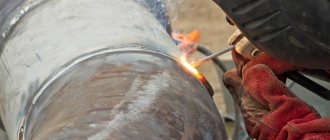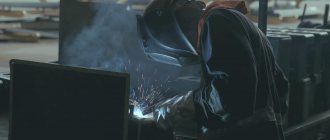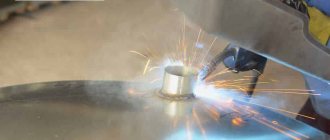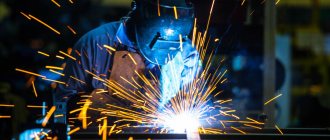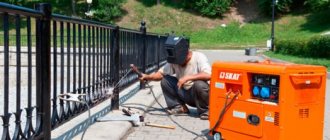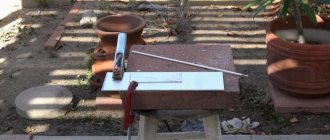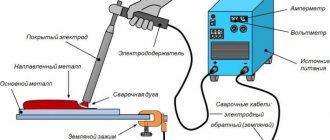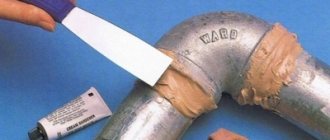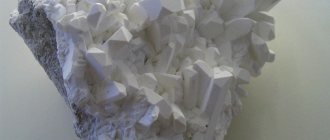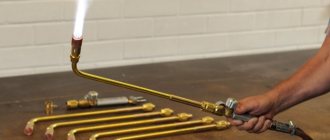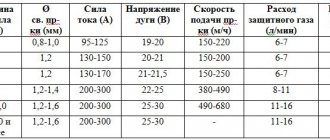The quality of the welding joint depends not only on the professional qualities of the worker, but also on the conditions of the work. An ideal weld requires the interaction of filler material and electrode without additional environmental elements. When welding in automatic mode, this function is performed by the flux coating of the electrode. The role of a person comes down to choosing the direction of arc movement and adjusting the current strength. Working in semi-automatic mode gives more freedom. The welding wire does not have a protective coating, therefore the work is carried out in an environment of protective gases, with manual adjustment of the feed rate of the filler material. Thus, the semi-automatic mode is more demanding on the qualifications of the welder, who, having the necessary skills, will achieve better soldering quality compared to the automatic mode. This is the difference between automatic and semi-automatic welding.
Application area
The use of all types of welding wires, with the exception of self-shielding, involves the use of shielding gas. Semi-automatic - equipment of experienced specialists . With its help, the delicate work of joining non-ferrous and ferrous metals, vehicle body repairs and industrial joining of thin-walled elements is performed. What gas is needed for semi-automatic welding will be discussed below.
Welding technology
The technology of gas welding will be the same both in the case of using a welding mixture and in the case of using carbon dioxide. Below you can see a table with recommended welding modes in carbon dioxide.
When gas welding, it is extremely important to follow safety precautions. Before work, be sure to check all components, their functionality and serviceability. This is especially true for the gas supply valve for semi-automatic welding machines. During welding work, the gas must completely fill the weld pool, only in this case its use will give the desired result.
What gas is needed
To choose which gas to use when welding semi-automatically, you need to have an idea of the physical and chemical properties of the gas. There are three main categories:
- inert;
- active;
- mixtures of gases.
Let's take a closer look at them.
The choice of gas also depends on the characteristics of the welding machine and the type of surface. For example, pure nitrogen is ideal for joining copper parts.
Acetylene
This organic compound is most widespread . The gas is lighter than air, colorless, has a specific odor, and has a high combustion temperature, which is why it is used in gas cutting of metal products.
For the industrial production of acetylene, special generators are used in which calcium carbide interacts with water.
The only drawback is difficulty in storage, since carbon carbide easily absorbs moisture from the atmosphere, which creates additional inconvenience.
Hydrogen
Widely used for joining aluminum products and plasma cutting of stainless steel. The gas is colorless and odorless. Explosive . When combined with air or water, it forms an explosive mixture. It is obtained by synthesizing water by separating oxygen and hydrogen in special generators. According to safety regulations, it is prohibited to store hydrogen in cylinders under pressure exceeding 15 MPa.
Coke
A by-product of the coke industry, which is formed during the production of coke. The gas is colorless with a pungent odor. Its storage is not subject to such stringent requirements as hydrogen, despite the fact that the gas is classified as explosive. Gas is transported using pipelines . It is not widely used due to the specifics of production. Applicable only in industrial areas.
Natural
Representatives of the organic group of hydrocarbon compounds are methane, propane and butane . Meet all requirements for welding gases. The advantages include the prevalence of this type, as well as the relatively low cost. The requirements for storage conditions are not strict - it is permissible to store cylinders outside, if a special cage with a canopy is built. Artificial synthesis is impossible. It is extracted only from natural deposits.
Pyrolysis
This type compares favorably with its counterparts - it does not need to be generated, since pyrolysis gas is released during the breakdown of petroleum products . Before use, it must be pre-cleaned due to excessive chemical activity, which can lead to corrosion of the burner. Suitable for both welding and cutting metal structures.
Clean
This group includes the following gases:
- Argon . In its pure form it is used only for argon arc welding. It is included in various mixtures as one of the components. Chemical inertness makes argon the optimal choice when working with refractory materials. It has low thermal conductivity and ionization potential.
- Helium . Another representative of the chemically inert group. Compared to argon, it has higher thermal conductivity and ionization potential.
These properties of helium provide a connection with greater heat input than argon, increasing the width of the welding profile.
- Carbon dioxide . The cheapest gas of all listed. This circumstance ensures wide popularity when carrying out work under limited budget conditions. Positive qualities include deep penetrating abilities, especially useful when joining thick sheet steel. The main disadvantage is poor arc stabilization, and as a result, a fairly large amount of splashes.
A distinctive feature of this gas is that it can be used without the addition of inert gases.
Gases used as mixture components
The best known additive component is oxygen . High chemical activity affects the percentage in the mixture - its mass fraction rarely exceeds 7-10%. A mixture of argon and oxygen has a specific melting pattern.
A weld made using this mixture is known as a “nail head”, named due to its external resemblance. Three-component mixtures are known, which include oxygen, argon and carbon dioxide, with different proportions, depending on the nature of the work.
Nitrogen is not widely used as a shielding gas. It is mainly used to join copper and stainless steel, since it does not react with these metals.
Gas welding mixtures and recommended areas of their application.
Carbon dioxide
Carbon dioxide is a chemically active element. In welding production, colorless and odorless carbon dioxide has established itself as an inexpensive substance . When connecting metal parts, it acts as a shielding gas in the formation of the weld seam. Its greatest application is in semi-automatic welding. The shelf life of a forty-liter cylinder is 2 years . For individual needs: for home, garage, cottage, you can purchase cylinders of smaller capacity.
Before welding, metal sheets with a thickness of more than 10 mm are cut into edges to improve the weldability of the weld.
During the carbon dioxide welding process, metal structures do not undergo deformation , which helps to avoid defects during operation. Thorough cleaning of the material is not required, since before joining the parts, the quality of the seam will not suffer from this.
The operating method is based on the initiation of an electric arc, which leads to metal melting, and the process is accompanied by the supply of carbon dioxide, a protective gas. The feed envelops the welding zone and plays the role of protection. The weld seam is not subject to oxidation.
When processing thick metals, carbon dioxide generates a lot of heat, which creates favorable conditions for the use of this method.
Criterias of choice
It is sometimes difficult for a beginner to choose which cylinder is needed for a semi-automatic machine, not to mention the gas mixture. Experienced experts recommend paying attention to the temperature limit and the amount of heat that is released when gas burns. Comparative characteristics of welding gases are freely available.
Important! If you purchase gas for long-term storage, we recommend choosing ready-made industrial mixtures. Do not synthesize gas yourself - it is unsafe!
Table of advantages and disadvantages
| Name | Advantages | Flaws |
| Welding mixtures | + increase in productivity due to increasing the mass of deposited metal per unit time; + reduction of excess consumption of filler material by reducing the amount of splashes; + increased joint plasticity and density due to less pore formation and, accordingly, a significant increase in joint strength; + reducing the amount of harmful aerosols and fumes in the workplace, which improves hygienic working conditions; + process stability even with uneven supply of filler wire. | — for a mixture of argon with oxygen, increased oxidation of metals, which reduces the strength of seams, as well as the formation of carbon monoxide, which is harmful to health; — a mixture of argon and carbon dioxide is explosive, which requires special precautions when carrying out work; — when working with a mixture of argon and carbon dioxide, carbon monoxide is also formed due to the interaction of carbon dioxide with atmospheric oxygen, so the operator must work in a special mask. |
| Carbon dioxide | + the ability to weld thin metal sheets that do not deform, as well as relatively thick workpieces in any spatial position, that is, to make horizontal, vertical and ceiling seams; + formation of a good arc, which is convenient for welders with little experience; + low cost of the welding method and carbon dioxide itself; + safety at work; + the ability to weld metals with different characteristics; + simplicity and availability of equipment for welding; + high quality of the resulting seams; + when connecting parts with a large thickness of metal, carbon dioxide releases a lot of heat, which increases productivity. | — increased spatter formation, which makes it necessary to clean welds after welding; - the strength characteristics of the seams are lower than with submerged arc welding methods or coated electrodes, so it is not recommended to use this method for parts that will operate under low temperatures or shock loads. |
Execution Features
Gas shielded welding has the following features that require attention:
- Work parameters . They are selected individually for each specific situation. It is possible to obtain a high-quality connection only if you combine the following parameters correctly: power, wire type, feed speed, gas consumption.
- Temperature regime . The working plane of the metal is heated and cooled over a long period of time. When connecting certain types of surfaces, for example, steel or copper, it is possible to regulate the temperature by changing the angle of the arc.
- Gas selection . There are two ways to do the work. In the first case, it is necessary to use carbon dioxide without adding any impurities. The second option is to use various mixtures based on argon or other inert elements.
- Nature of work . The main purpose of the cylinders is stationary work in a workshop environment. There are some inconveniences associated with using high pressure tanks in open areas.
Connection diagram for a carbon dioxide cylinder to a gas main.
The technology of working with carbon dioxide is not fundamentally different from activities using other gas mixtures. The most important thing is to comply with technological requirements.
Features of welding with argon mixtures
During the welding process, it is important to take into account some features of the welding mixtures used. First of all, you need to position the torch closer to the welding zone and, if possible, keep the torch closer to the vertical position. The electrode extension on the burner should be no more than 15-20 mm. When these dimensions increase, air leaks and the formation of pores in the weld are possible.
Secondly, when working with mixtures, it is important to correctly set the gas flow rate in the welding torch. It is recommended that the gas flow rate in the burner (in l/min) should be set approximately equal to the burner diameter (in mm). In fact, 10-15 l.min. is usually sufficient. Physically, the gas flow can be controlled directly on the burner, for example, using a gas rotameter). When the gas flow rate in the burner decreases below 5-7 l/min and when the gas flow rate increases to more than 25-30 l/min, air leaks and the formation of pores in the weld are possible.
Thirdly, the presence of argon or oxygen in the mixture increases the fluidity of the molten metal in the weld pool. Therefore, when working with mixtures, the gap between the workpieces should be significantly smaller than for carbon dioxide. For the same reason, difficulties may arise when welding vertical seams. To compensate for this effect, it is necessary to reduce welding modes or use mixtures with a minimum argon content.
When working with welding mixtures, the consumption of welding wire is significantly reduced (up to 20%) and therefore excess wire often leads to the formation of a reinforced weld bead. In addition, the welding modes for welding mixtures do not correspond to the usual welding modes for pure carbon dioxide. Therefore, it is necessary to correctly set the welding modes (arc voltage, current or welding wire feed speed) and practice new welding skills, including increasing the welding speed.
When working with argon mixtures, the thermal conductivity of the gas flow in the burner decreases and the heating of the burners increases. When working in forced modes, it is necessary to use burners that are more powerful than usual.
Advantages
Regardless of the type of gas mixture, its use has a number of advantages:
- Connection quality . The physical properties of the seam are much higher compared to using the automatic mode. Low amount of spatter during the joining process.
- Labor productivity . Operational efficiency is increased by reducing the heating time of the metal, which ultimately reduces labor costs.
- Stable arc . Makes work much easier. An additional advantage is the almost complete absence of smoke.
For car repair
The advent of household semi-automatic machines has made it possible to carry out car body repairs in almost any garage with a network connection. Welding in a carbon dioxide environment has the following advantages:
- Technological simplicity - the basics of working with a semi-automatic machine are understandable to a wide range of people;
- The low price of carbon dioxide has a positive effect on the cost of work;
- Low temperature impact zone to weld products of almost any thickness;
- Due to the limited temperature effect, the paint around the seam practically does not fade, which saves time and money on finishing;
- The connected elements do not require adjustment.
Welding mixtures
The main component of welding mixtures is the inert gas argon, which can be mixed not only with other inert gases, but also with active gases. In addition, active varieties can also be mixed with each other. The following welding mixtures are used:
- Argon with carbon dioxide is used for welding products made of carbon and low-alloy steels. The mixture promotes a more even and plastic formation of the seam, reduces pore formation, and facilitates the transfer of electrode material;
- Argon with oxygen (no more than 5%) – used when working with products made of alloy and low-alloy steels. Increases weld density by reducing metal porosity and facilitates the process of jet transfer of electrode material. Allows the use of a wider range of filler wire;
- Argon with hydrogen - used to connect parts made of stainless steel and nickel alloys;
- Argon and helium - creates a completely inert environment, used to connect elements made of aluminum, copper and titanium, as well as chromium-nickel steel;
- Carbon dioxide and oxygen - used when welding carbon and low-alloy steels. Allows you to form a more even seam by preventing metal spattering, increases productivity due to a significant increase in temperature in the welding zone. The disadvantages include increased oxidation of the material, which reduces the strength properties of the connection.
